
Renaissance is an era of great names
The Renaissance (Rinascimento) is a culturally significant era spanning nearly three centuries and marked by the flourishing of the arts. Even those who are not particularly interested in painting are familiar with the term "Renaissance" and have heard the names of Leonardo da Vinci, Giorgione, Botticelli, Raphael, Titian, Michelangelo, and more. However, this is just the tip of the iceberg: dozens of their colleagues, recognized giants in the history of art, have their creations included in the golden fund of famous museums worldwide. And this is not to mention hundreds of artists commonly referred to as "ordinary." After all, almost every European ruler patronized painting during the Renaissance! The aristocracy also made an effort not to lag behind.
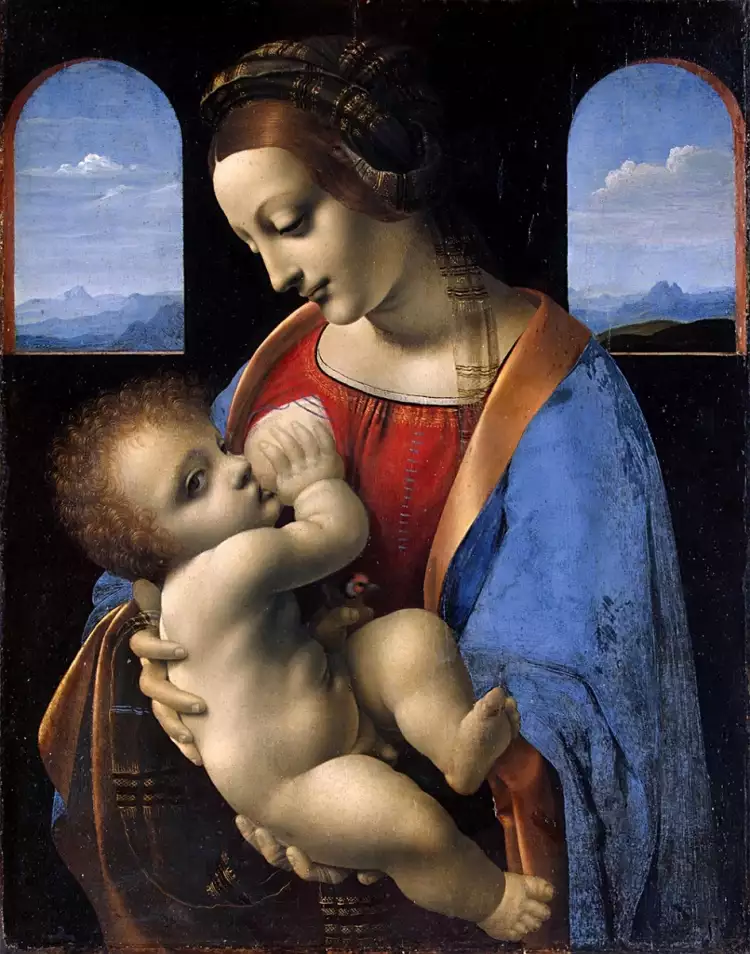 Renaissance. Leonardo da Vinci. Madonna Litta, 1490
Renaissance. Leonardo da Vinci. Madonna Litta, 1490
The significance of the Renaissance is measured not only by the quantity of remarkable works. During the Renaissance, there were qualitative changes in all areas of culture. The canons of the Middle Ages gave way to a new art: humanistic, anthropocentric, secular, and realistic. The artistic foundations of the masters of the entire modern era were laid. No matter which direction we look at, up to the fundamental ideological shift at the end of the 19th to the beginning of the 20th centuries, all of them grew out of the cradle of the Renaissance.
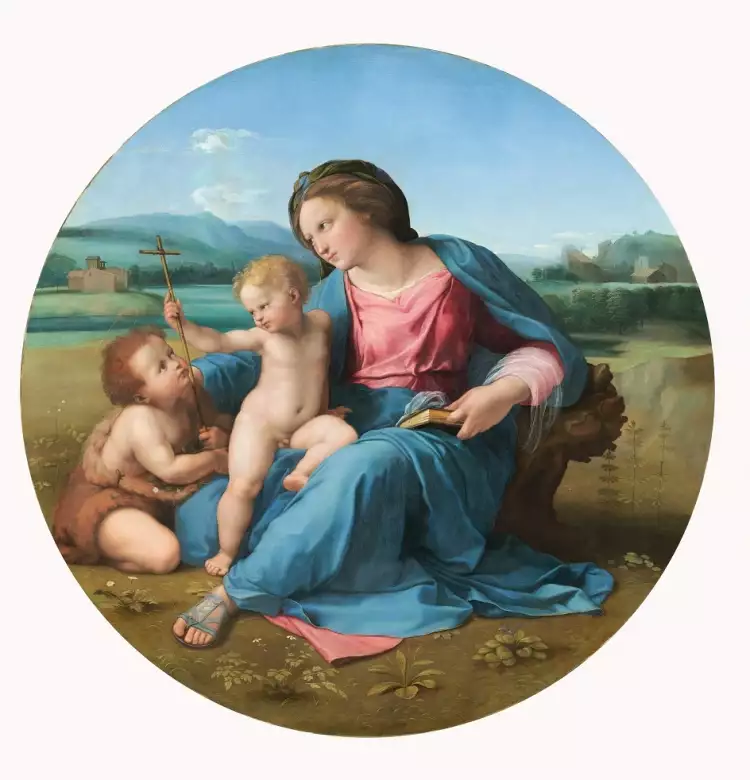 Renaissance. Raffaello Santi. Alba Madonna, 1511
Renaissance. Raffaello Santi. Alba Madonna, 1511
The name for this period (the Italian word Rinascimento and the French word Renaissance both originate from the Latin renasci) was given by the contemporaries themselves. For example, the term is found in the writings of the Italian Giorgio Vasari, who was an artist, architect, and writer. The point is that the creators of this era, by rejecting medieval canons, proclaimed ancient art as their foundation. It was about a rebirth of the artistic principles of antiquity, which Renaissance masters saw as an ideal. But they were innovators, not imitators. Their creativity was not a blind copy; they built a magnificent palace on the ancient foundation, filling it with new content.
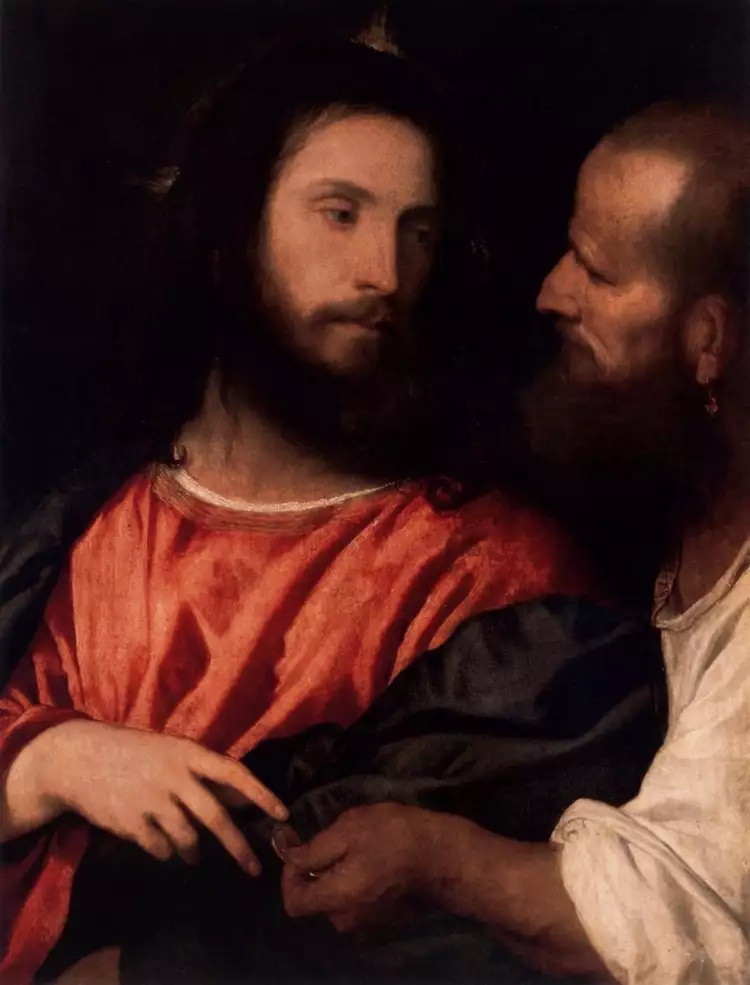 Renaissance. Tiziano. The Tribute Money, 1516
Renaissance. Tiziano. The Tribute Money, 1516
The term in its modern sense, that is, to denote a period in the history of culture, was introduced in the 19th century by the French historian Jules Michelet.
Historical milestones and periods of the Renaissance
The history of the Renaissance begins in the 15th century. The Renaissance-humanist dominant sound lasted for almost three centuries, from the early 1420s to the last quarter of the 16th century (the concluding chords were heard even in the early 17th century). Renaissance tendencies originated in Italy and then spread beyond the Alps, so in other countries, national Renaissance started later.
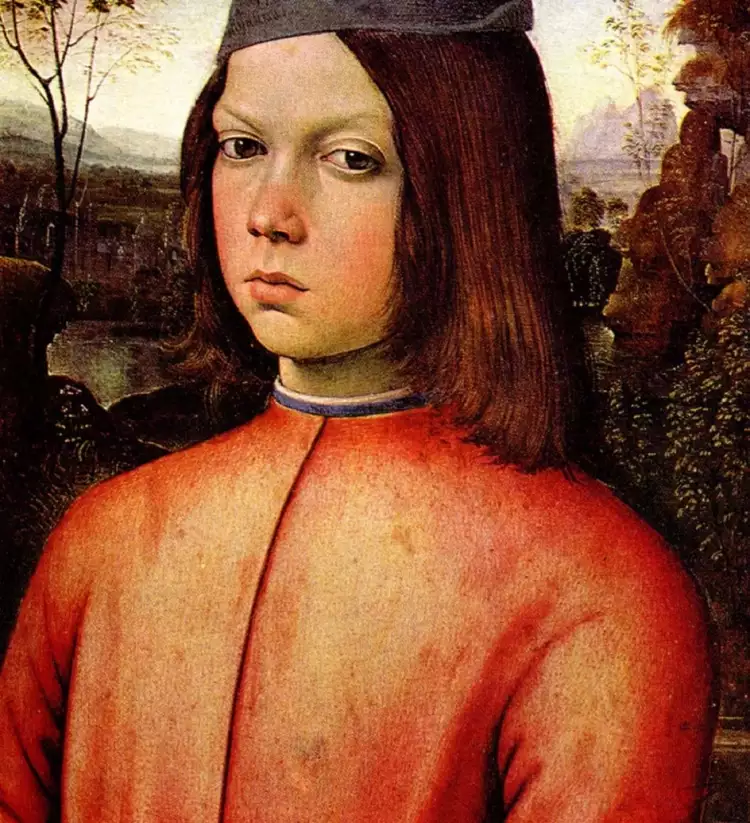 Renaissance. Pinturicchio. Portrait of a Boy, 1500
Renaissance. Pinturicchio. Portrait of a Boy, 1500
Of course, the new style did not emerge instantly. Innovative ideas gradually made their way during the Duecento and Trecento Proto-Renaissance periods, displacing Gothic and Byzantine motifs.
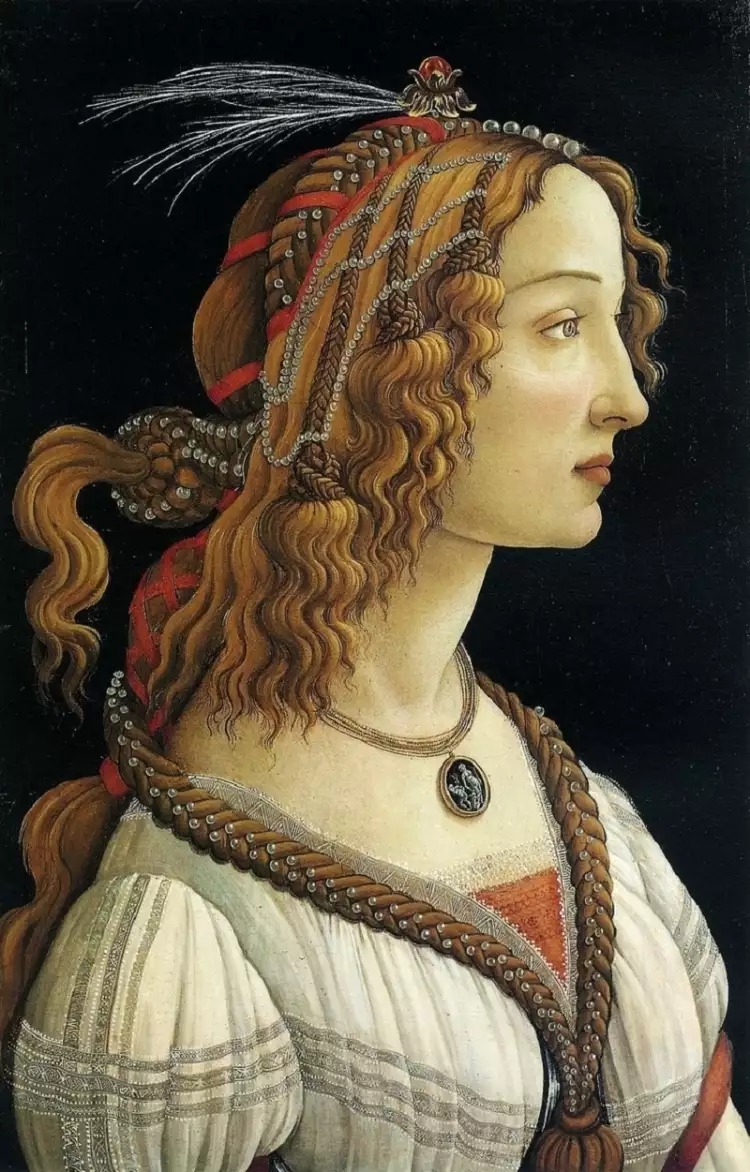 Renaissance. Sandro Botticelli. Portrait of a Young Woman, 1480-1485
Renaissance. Sandro Botticelli. Portrait of a Young Woman, 1480-1485
The Renaissance is divided into three periods:
- Early Renaissance - from the 1420s to the end of the 15th century.
- High Renaissance - from the late 15th century to the 1520s.
- Late Renaissance - until the end of the 16th century.
Early Renaissance — Fra Filippo Lippi, Ghirlandaio, and Botticelli
The beginning of the Renaissance era is considered to be the 1420s, with the brilliant city of Florence at the heart of this new style. The cautious pre-Renaissance innovation was replaced by a confident manifesto of humanist creators. Art became secular (which doesn't mean the disappearance of religious subjects, but rather a change in the nature of artistic creation). Anthropocentrism was declared the philosophical basis. As for technique, painters carefully studied ancient ideals, sought realism in forms and colors, and worked with perspective.
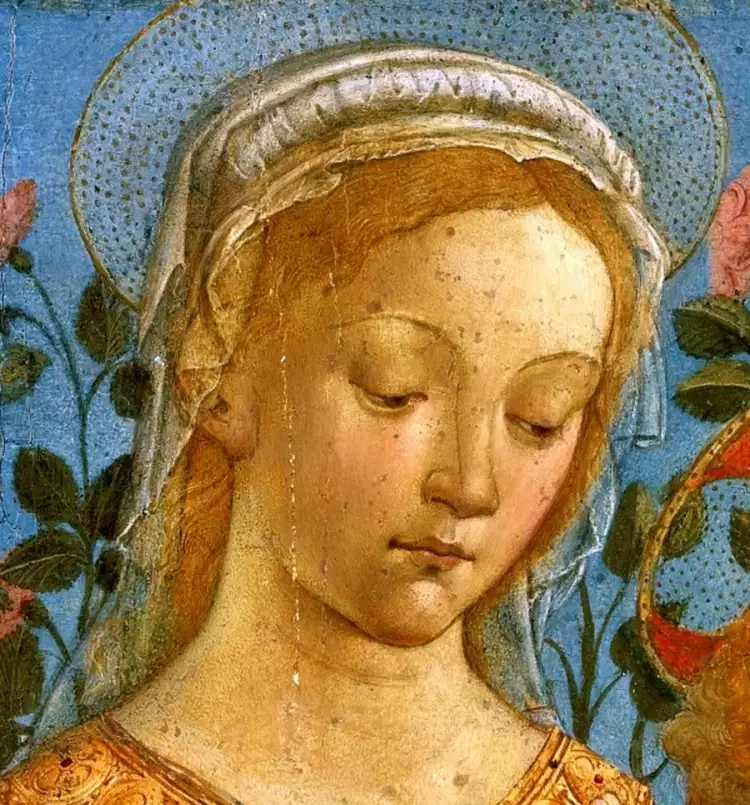 Renaissance. Andrea del Verrocchio. Madonna and a child resting on a parapet. Fragment
Renaissance. Andrea del Verrocchio. Madonna and a child resting on a parapet. Fragment
Masaccio, a reformer from the Florentine school, opposed the idealism of Gothic with realism. He paid great attention to conveying individuality; for example, in "The Tribute Money," each character has their own distinct personality.
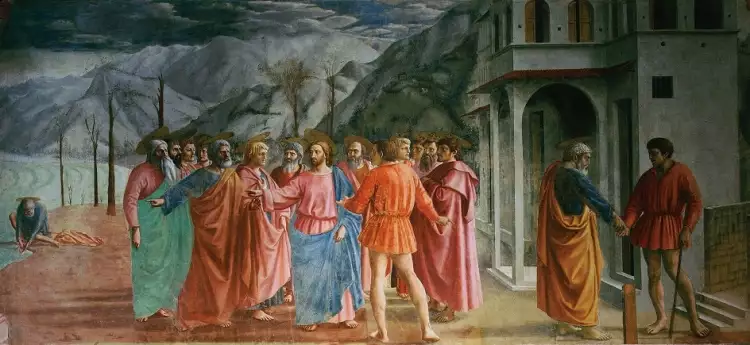 Renaissance. Masaccio. The Tribute Money, 1425-1428
Renaissance. Masaccio. The Tribute Money, 1425-1428
Fra Filippo Lippi was a monk (Fra is not part of his name but a term for monks in Italy, derived from the word "frate," meaning brother). However, despite his monastic vows, he filled his paintings with sensuality and joy for life. But what can you expect from a man who abducted a young nun from the convent? Fra Filippo was a very intriguing figure!
In the example of his painting "Madonna with a Veil," we can see how religious subjects transition into the realm of secular art: the images are poetic but realistic. It's not surprising since the master's wife and children posed for him (the same woman he abducted; although their marriage was never officially recognized).
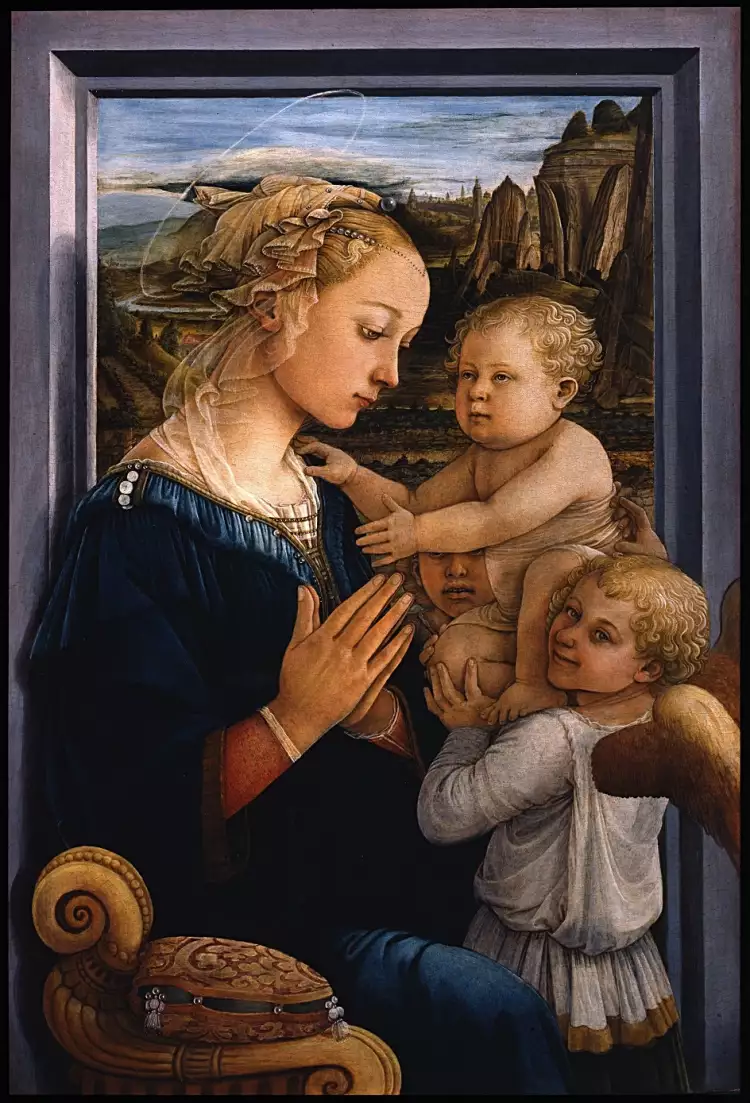 Renaissance. Fra Filippo Lippi. Madonna with the Child and two Angels, 1465
Renaissance. Fra Filippo Lippi. Madonna with the Child and two Angels, 1465
The influence of antiquity is demonstrated in Domenico Ghirlandaio's "Portrait of Giovanna Tornabuoni."
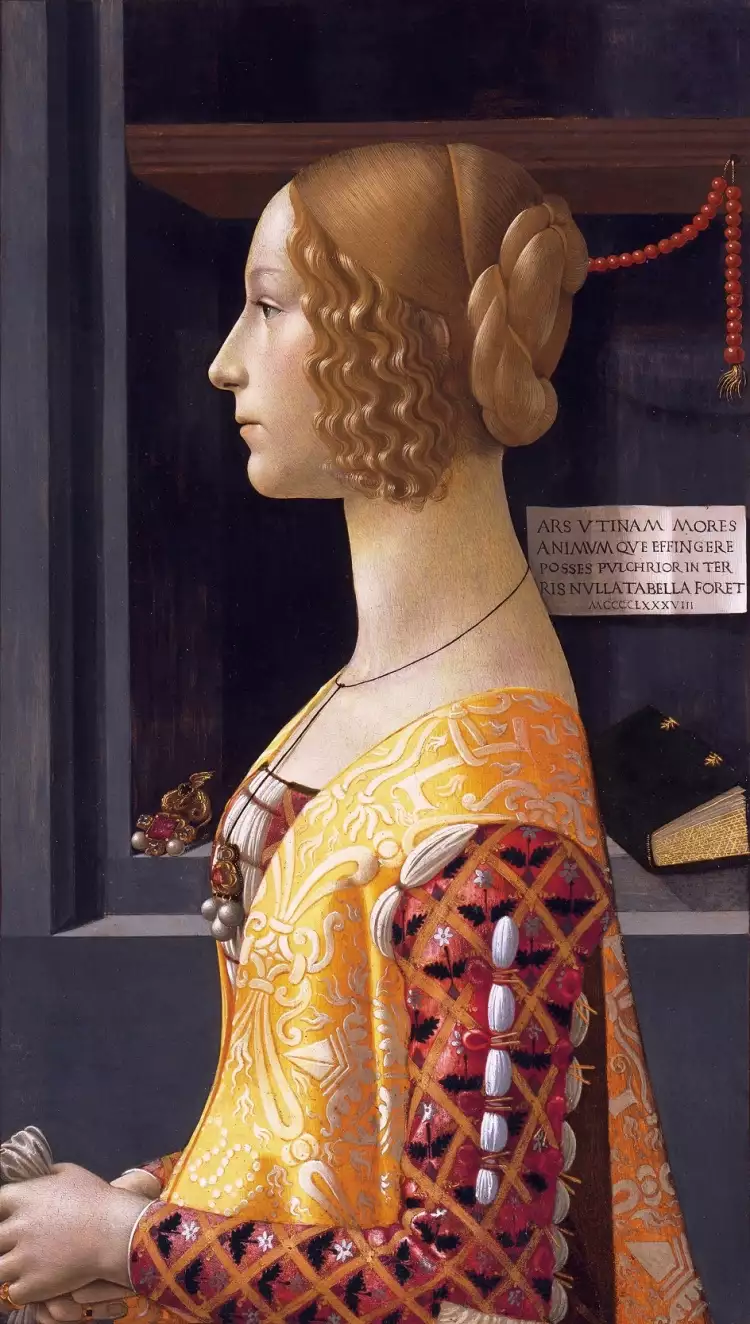 Renaissance. Domenico Ghirlandaio. Portrait of Giovanna Tornabuoni, 1488
Renaissance. Domenico Ghirlandaio. Portrait of Giovanna Tornabuoni, 1488
The strengthening influence of a realistic approach is noticeable in the "Portrait of an Old Man with a Young Boy," a superb example of the blossoming portrait genre.
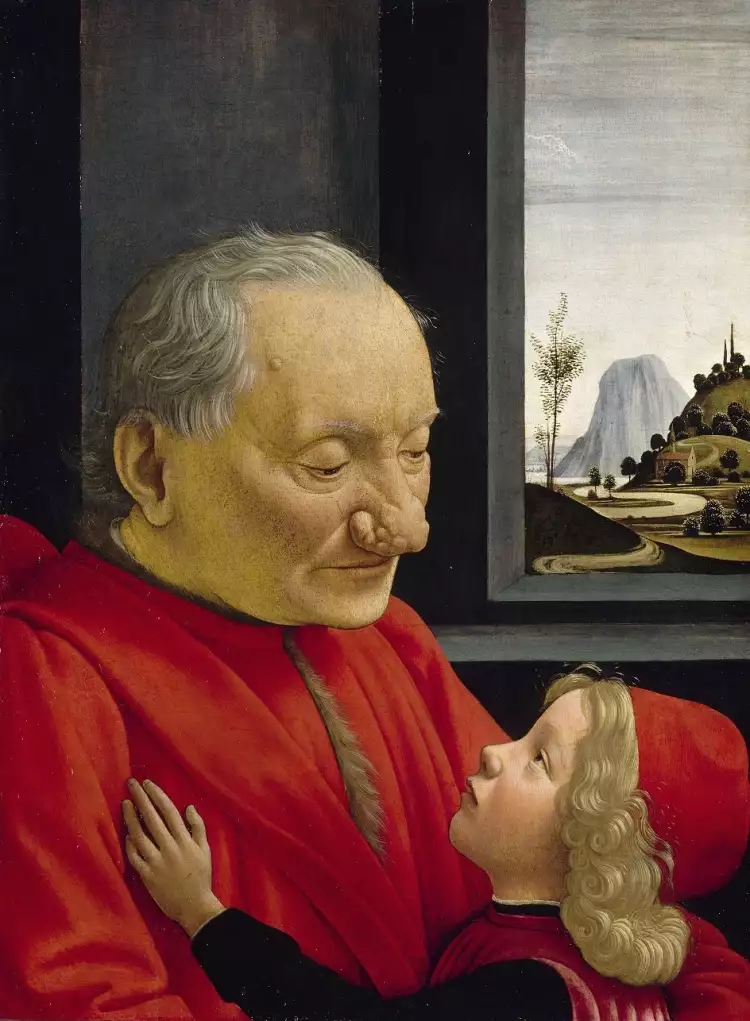 Renaissance. Domenico Ghirlandaio. An Old Man and his Grandson, 1490
Renaissance. Domenico Ghirlandaio. An Old Man and his Grandson, 1490
And, of course, Sandro Botticelli's "The Birth of Venus" is perhaps the most famous masterpiece of the Quattrocento.
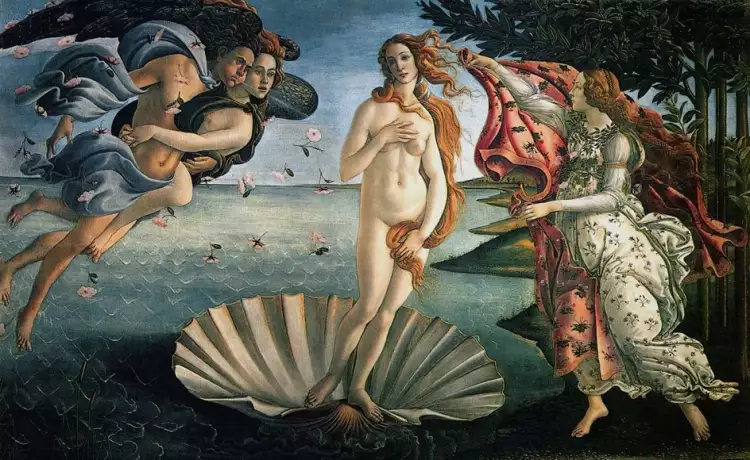 Renaissance. Sandro Botticelli. The Birth of Venus, 1484-1486
Renaissance. Sandro Botticelli. The Birth of Venus, 1484-1486
The same sensual and joyful atmosphere and musical color are found in "Primavera."
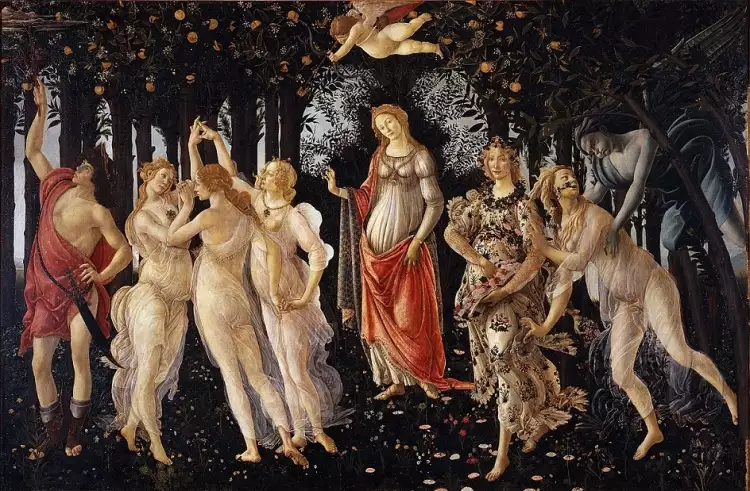 Renaissance. Sandro Botticelli. Primavera, circa 1480
Renaissance. Sandro Botticelli. Primavera, circa 1480
Botticelli's religious works are lyrically elevated and poetically musical. "Madonna of the Magnificat" impressed contemporaries so much that it was replicated in numerous copies.
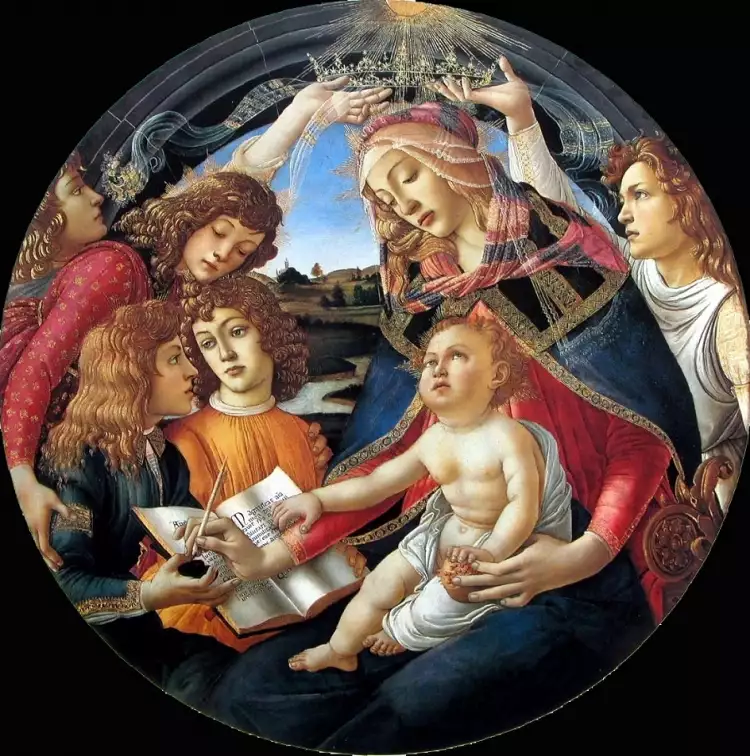 Renaissance. Sandro Botticelli. Madonna of the Magnificat, 1481
Renaissance. Sandro Botticelli. Madonna of the Magnificat, 1481
Botticelli's lines are called melodious. His remarkable plasticity makes his style of painting so expressive that he is among the most recognizable artists in history.
High Renaissance — da Vinci, Raphael, Michelangelo, and Titian
The pinnacle of the Renaissance is considered to be the thirty years from the creation of Leonardo da Vinci's "The Last Supper" in the 1490s. Rome becomes the center of attraction for artists during this period. Here, grand and ambitious works are created, such as Michelangelo's frescoes in the Sistine Chapel and Raphael's works in the Vatican Palace. Another center of Renaissance art was Venice, celebrated by artists like Titian and Giorgione.
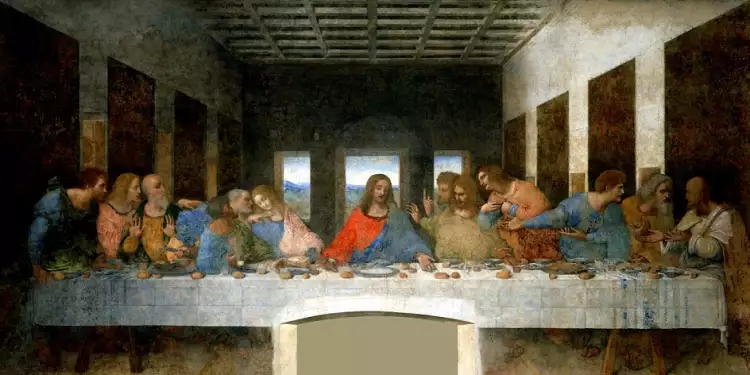 Renaissance. Leonardo da Vinci. The Last Supper, 1495-1498
Renaissance. Leonardo da Vinci. The Last Supper, 1495-1498
The techniques of representation reached new heights. Complex compositions, depth of space, and emotional richness became characteristic of frescoes and canvases.
Celebrating the beauty of humanity, humanist artists sought to depict the individuality of each character. To achieve this, they meticulously studied anatomical features and aimed to capture the subtle nuances of facial expressions. The famous "Mona Lisa" still captivates the world with the mystery of her smile.
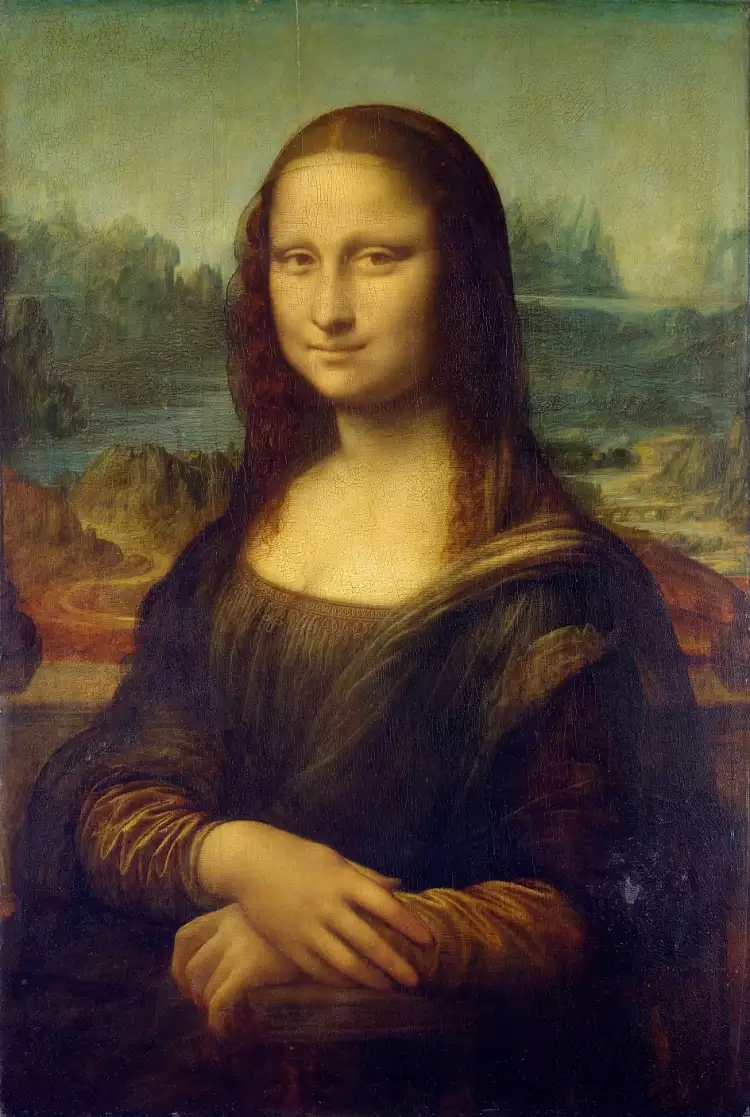 Renaissance. Leonardo da Vinci. Mona Lisa, 1503-1506
Renaissance. Leonardo da Vinci. Mona Lisa, 1503-1506
These thirty years are remarkable for the concentration of masterpieces and great names.
LEONARDO DA VINCI (Leonardo di ser Piero da Vinci). His major works include:
- Madonnas Benois and Litta.
- The Mona Lisa.
- Lady with an Ermine.
- Monumental fresco in the Milanese monastery of Santa Maria delle Grazie, The Last Supper.
- The Vitruvian Man, demonstrating canonical proportions.
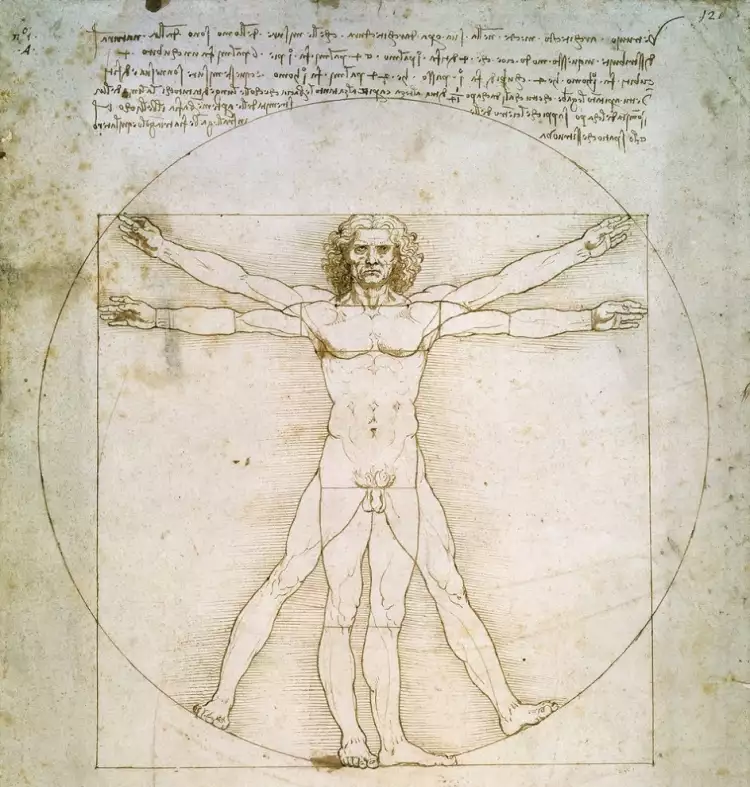 Renaissance. Leonardo da Vinci. Vitruvian Man, 1490
Renaissance. Leonardo da Vinci. Vitruvian Man, 1490
A characteristic feature of Leonardo's work is the soft blurring known as sfumato. He invented this technique, allowing him to literally "paint the air."
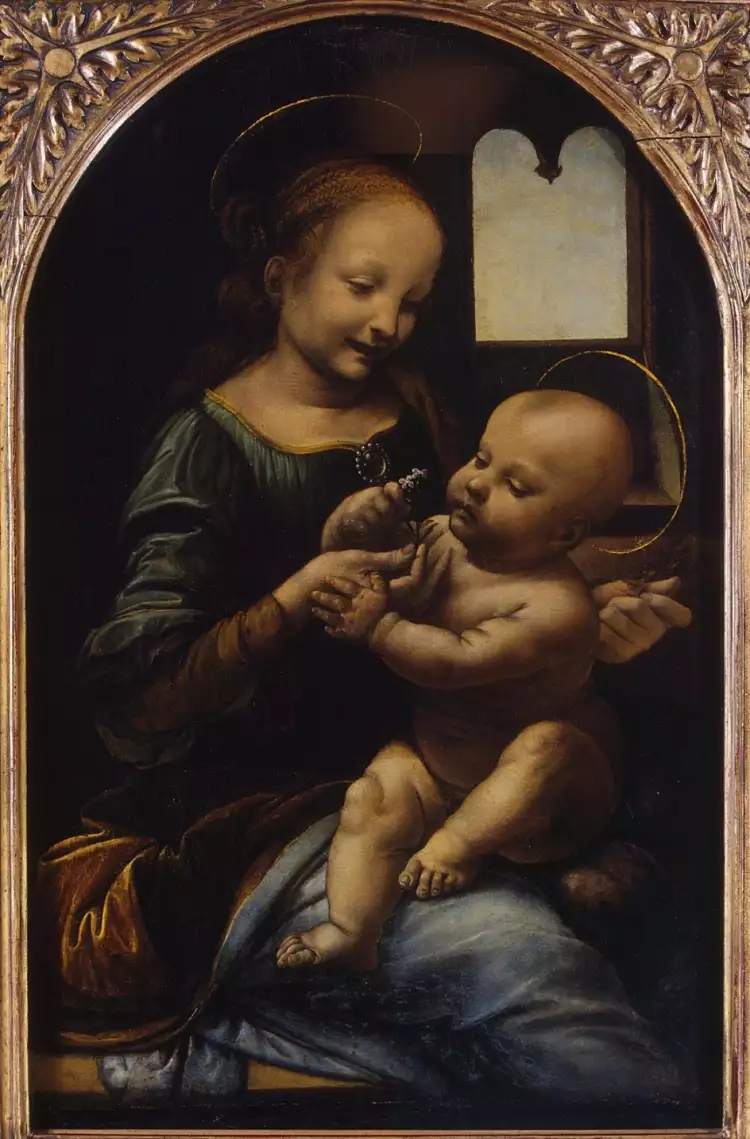 Renaissance. Leonardo da Vinci. Benois Madonna, 1478-1480
Renaissance. Leonardo da Vinci. Benois Madonna, 1478-1480
An interesting detail: modern researchers have discovered that the genius was able to apply paint in layers as thin as two microns!
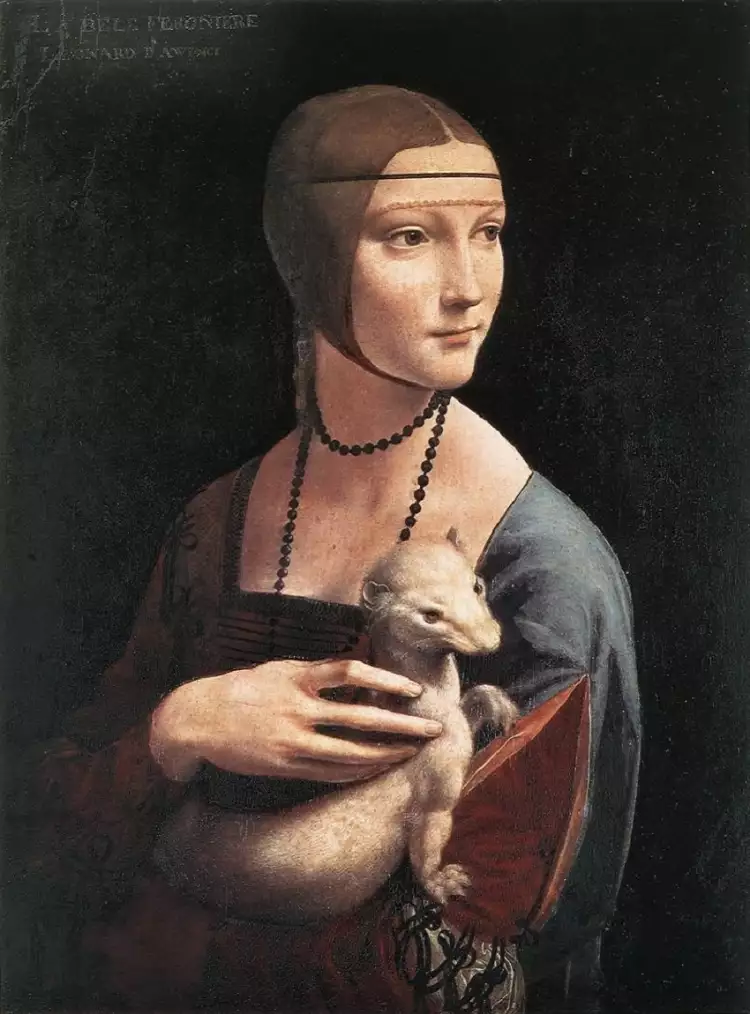 Renaissance. Leonardo da Vinci. Lady with an Ermine, 1489-1491
Renaissance. Leonardo da Vinci. Lady with an Ermine, 1489-1491
RAFFAELLO SANZIO (Raffaello Santi), whose art reflects the brightest and most sublime ideals. His combination of colors, graceful lines, and compositional harmony is enchanting. He incredibly managed to combine a bright palette with impeccable taste. His paintings are filled with air and light.
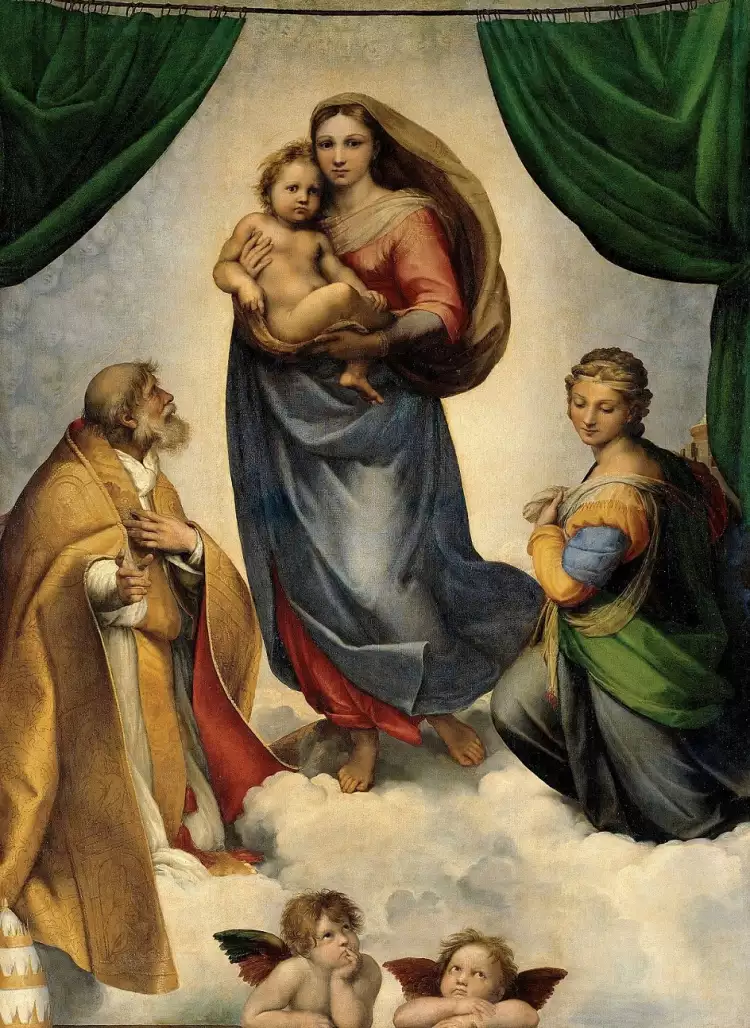 Renaissance. Raffaello Santi. Sistine Madonna, 1513-1514
Renaissance. Raffaello Santi. Sistine Madonna, 1513-1514
Raphael's masterpieces include:
- One of the most recognizable paintings in the world - the majestic and lyrical Sistine Madonna.
- Madonnas Connestabile, Alba and With a Goldfinch.
- The Holy Family.
- Portrait of Baldassare Castiglione.
- Lady with a Unicorn.
- The grand Transfiguration.
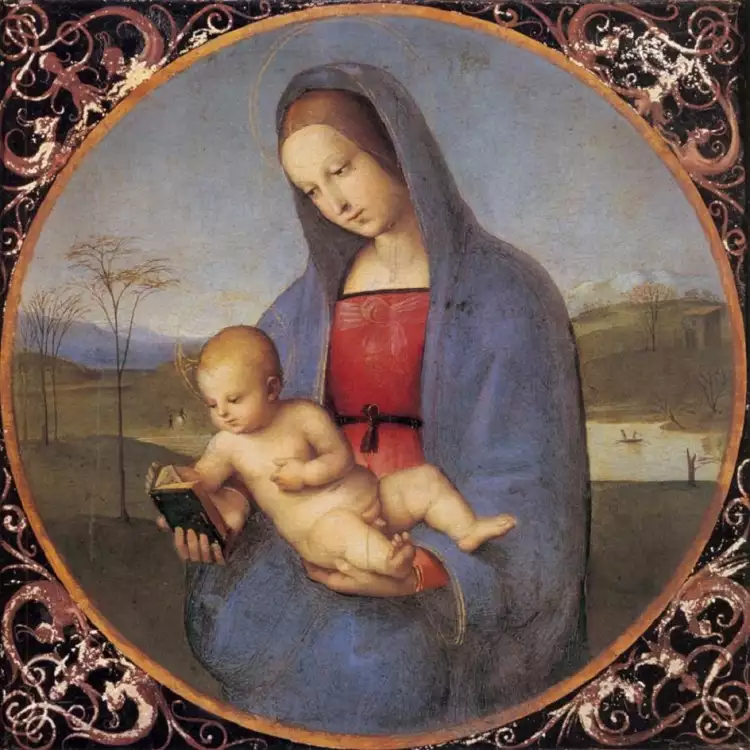 Renaissance. Raffaello Santi. Madonna Connestabile, 1502-1504
Renaissance. Raffaello Santi. Madonna Connestabile, 1502-1504
And, of course, it is impossible not to mention the frescoes "Parnassus" and "The School of Athens."
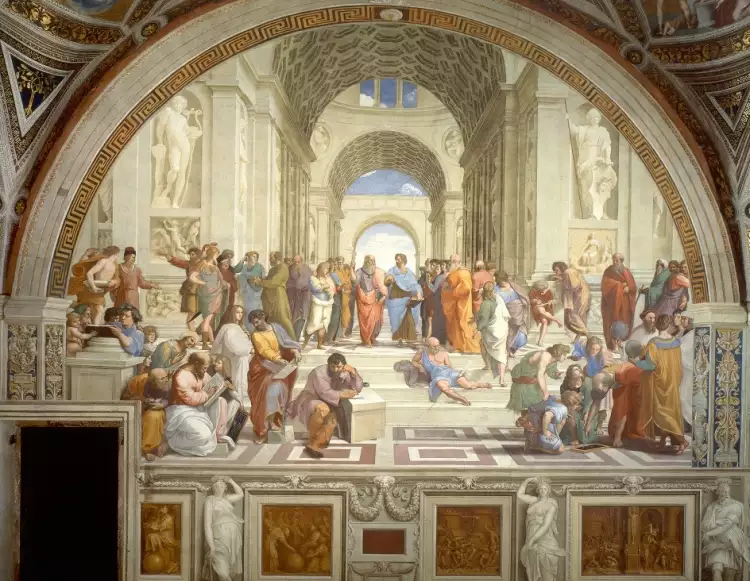 Renaissance. Raffaello Santi. The School of Athens, 1509-1511
Renaissance. Raffaello Santi. The School of Athens, 1509-1511
MICHELANGELO BUONARROTI (Michelangelo di Lodovico di Leonardo di Buonarroti Simoni), who achieved exceptional heights in representing the human body.
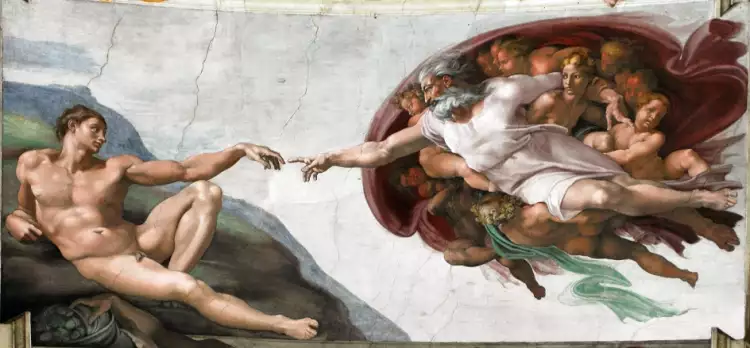 Renaissance. Michelangelo Buonarroti. The Creation of Adam, 1508-1512
Renaissance. Michelangelo Buonarroti. The Creation of Adam, 1508-1512
Michelangelo is best known as a genius sculptor, of whom it was said: with his "David," he stole the fame of Greek and Roman statues. But he also had painted masterpieces - the frescoes "The Creation of Adam" and "The Last Judgment."
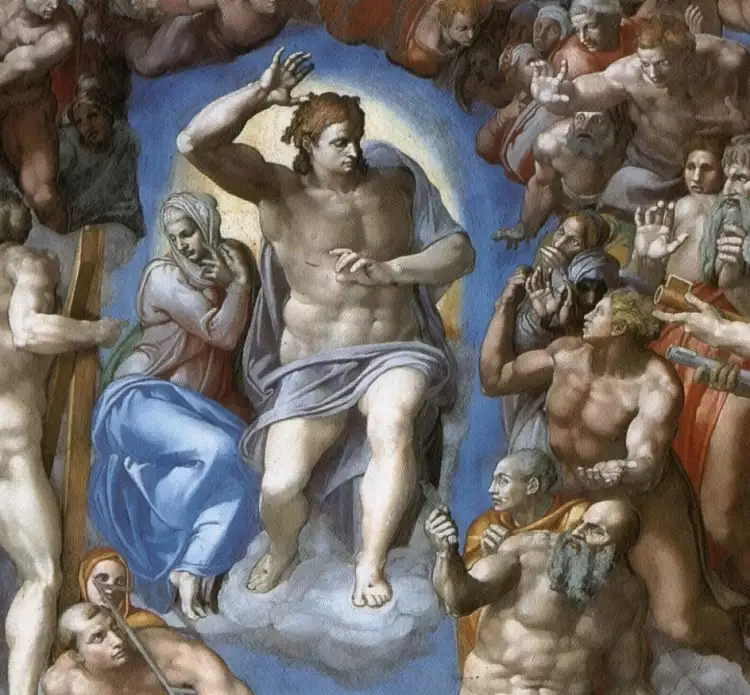 Renaissance. Michelangelo Buonarroti. The Last Judgment, 1536-1541. Fragment
Renaissance. Michelangelo Buonarroti. The Last Judgment, 1536-1541. Fragment
TIZIANO (Tiziano Vecellio), leading the Venetian school. His paintings captivate with magnificent color.
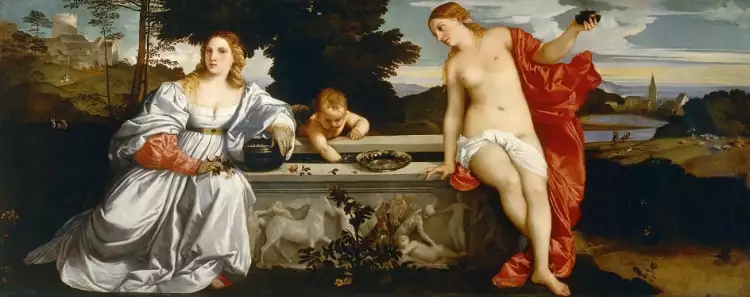 Renaissance. Tiziano. Sacred and Profane Love, 1514
Renaissance. Tiziano. Sacred and Profane Love, 1514
He masterfully worked with half-tones, creating amazing plays of light and shadow, filling space with airy nuances. The colorist's talent is most vividly expressed in his later works.
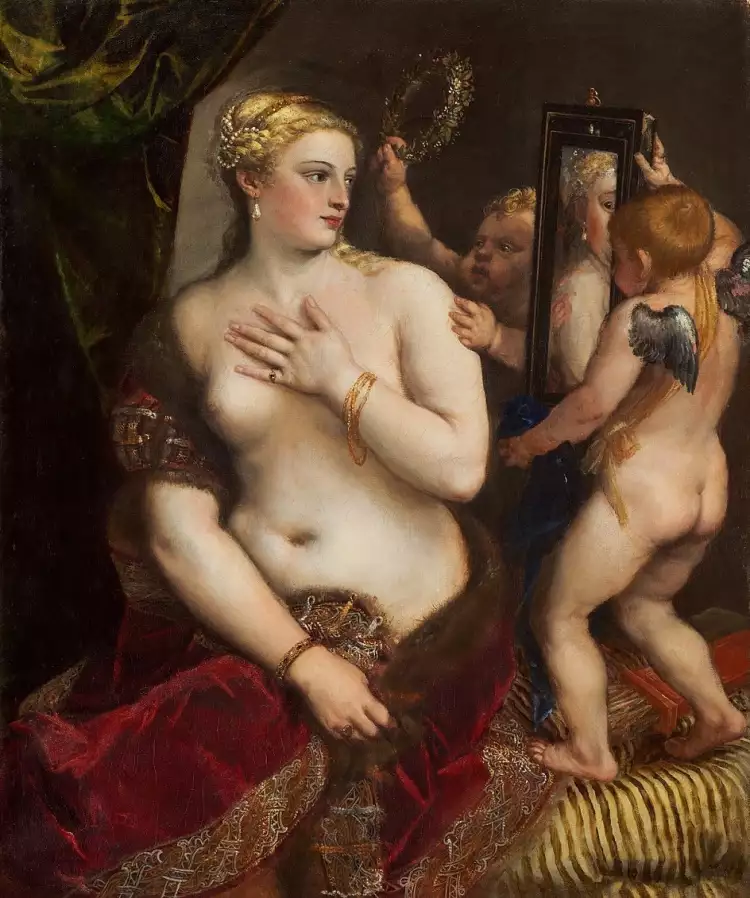 Renaissance. Tiziano. Venus with a Mirror, 1555
Renaissance. Tiziano. Venus with a Mirror, 1555
Titian's paintings are filled with juicy, colorful eroticism. " Sacred and Profane Love," "Venus in Front of the Mirror," "Venus and Adonis," and the famous "Venus of Urbino" are splendid hymns to beauty and the joys of life.
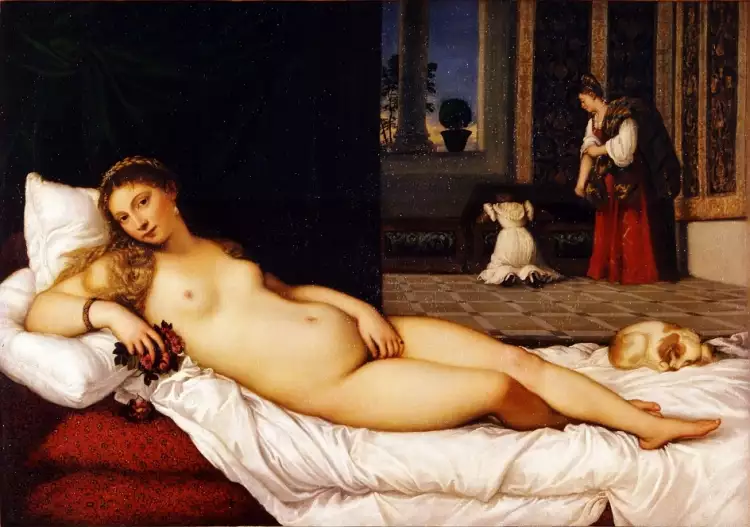 Renaissance. Tiziano. Venus of Urbino, 1538
Renaissance. Tiziano. Venus of Urbino, 1538
But he also created works filled with profound drama, such as "The Tribute Money" and "Penitent Mary Magdalene."
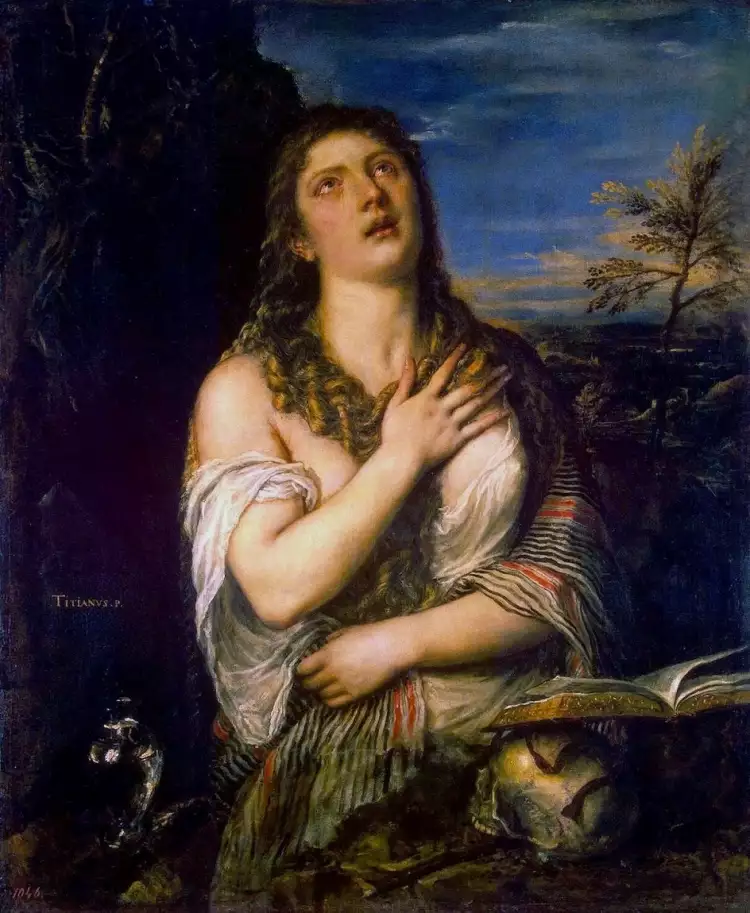 Renaissance. Tiziano. Penitent Magdalene, 1565
Renaissance. Tiziano. Penitent Magdalene, 1565
Titian also became famous as one of the greatest portraitists. Monarchs and princes, Roman popes and cardinals all sought to obtain a portrait painted by Titian. It is said that when the master was painting Charles V and dropped his brush, the monarch himself picked it up and said that even an emperor would be honored to serve Titian.
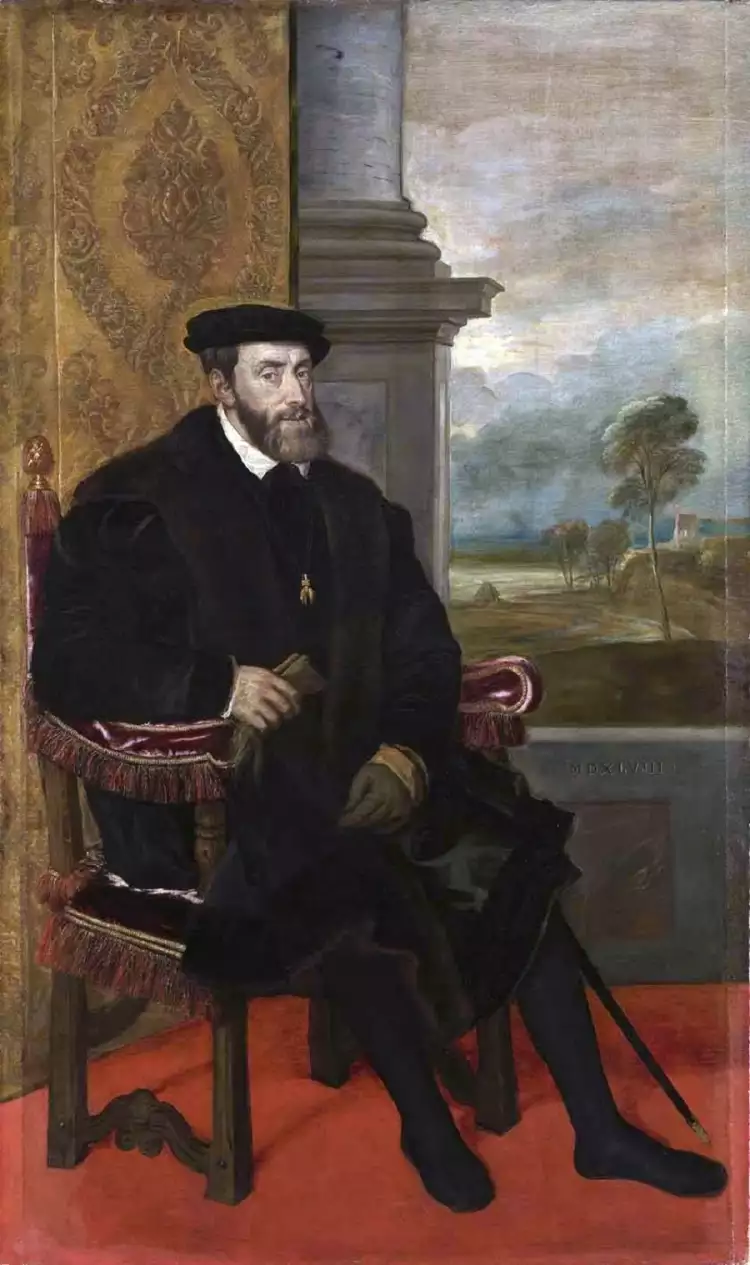 Renaissance. Tiziano. Portrait Charles V, 1548
Renaissance. Tiziano. Portrait Charles V, 1548
GIORGIONE (Giorgio Barbarelli da Castelfranco), another great Venetian artist. Color nuances, subtle gradations of light, expressiveness, and refined lines are characteristic of his technique. His subjects are emotional, and his images are spiritual and poetic. One of his most famous heroines is "Judith."
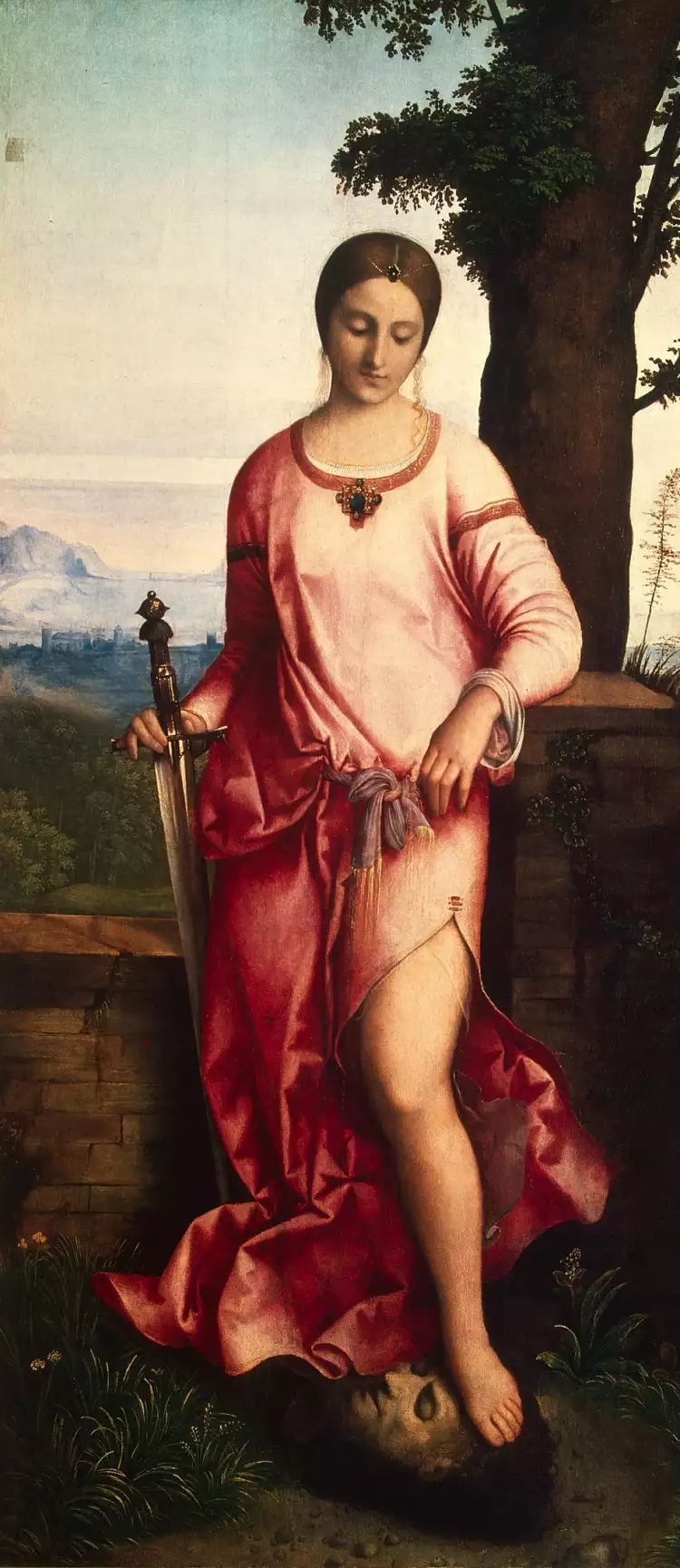 Renaissance. Giorgione. Judith, 1504
Renaissance. Giorgione. Judith, 1504
Giorgione's innovation is evident in the inclusion of nature in his paintings. They appear in "The Three Philosophers," "Solomon and the Queen of Sheba," "The Adoration of the Shepherds," "Madonna Castelfranco," and more. He was one of the first to pay attention to the beauty of nature, laying the groundwork for the recognition of landscape painting as a separate genre.
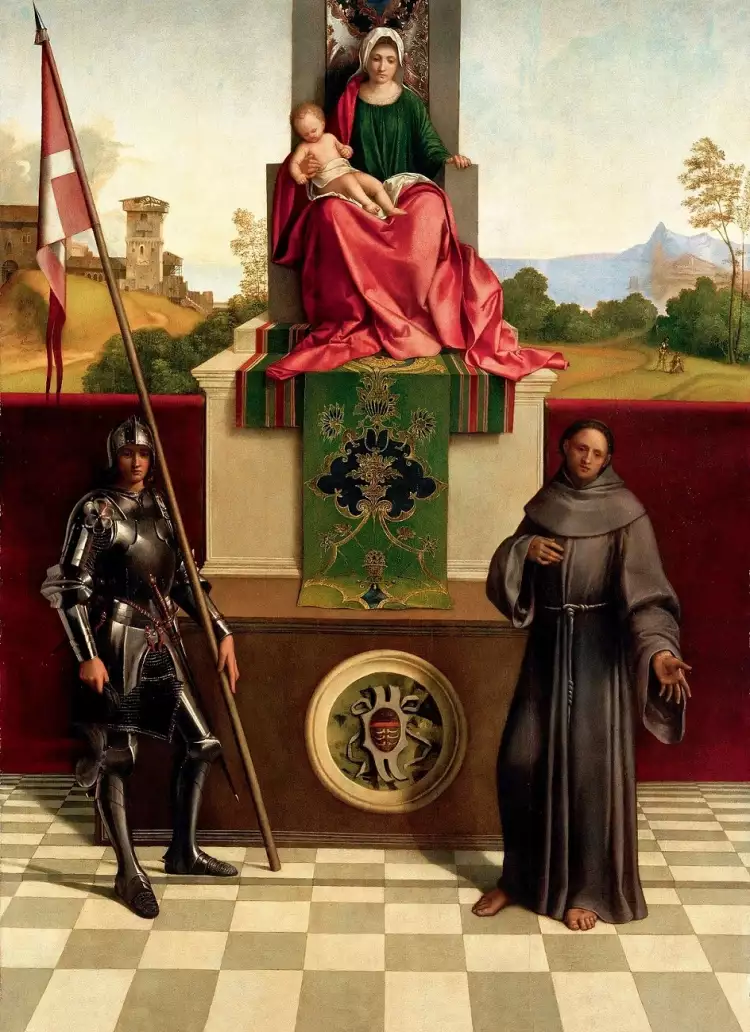 Renaissance. Giorgione. Castelfranco Madonna, 1503-1504
Renaissance. Giorgione. Castelfranco Madonna, 1503-1504
Late Renaissance
But nothing lasts forever. A crisis of ideas set in. On one hand, it was associated with the exhaustion of innovative potential, and on the other hand, with the changes occurring in public life. The 16th century proved to be a difficult period for Europe: first, the Reformation split it into two parts and triggered a long era of religious conflicts and civil wars, and then came the Counter-Reformation.
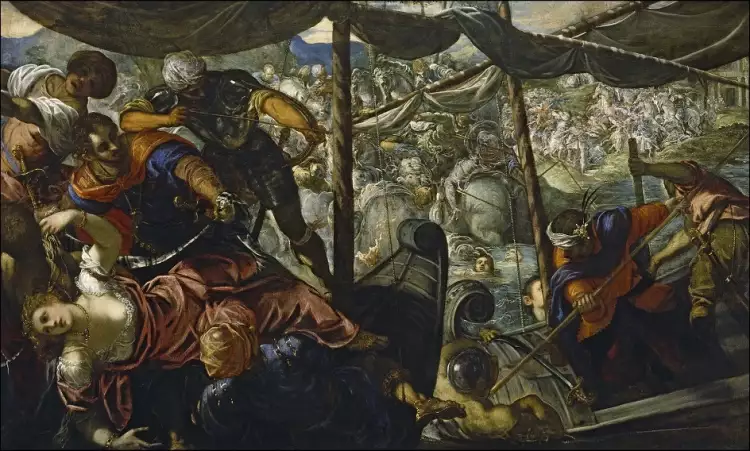 Renaissance. Jacopo Tintoretto. Elena's abduction, 1548
Renaissance. Jacopo Tintoretto. Elena's abduction, 1548
In the creative environment, there were fewer and fewer bearers of Renaissance ideals. Nevertheless, Michelangelo and Titian were still creating, and for them, the decline of the Renaissance coincided with the peak of their personal creativity. It could be said that this was the swan song of the Renaissance...
A special haven where the spirit of the Renaissance persisted for a long time was Venice. The work of Titian was continued here by Tintoretto, Jacopo Bassano, and Paolo Veronese.
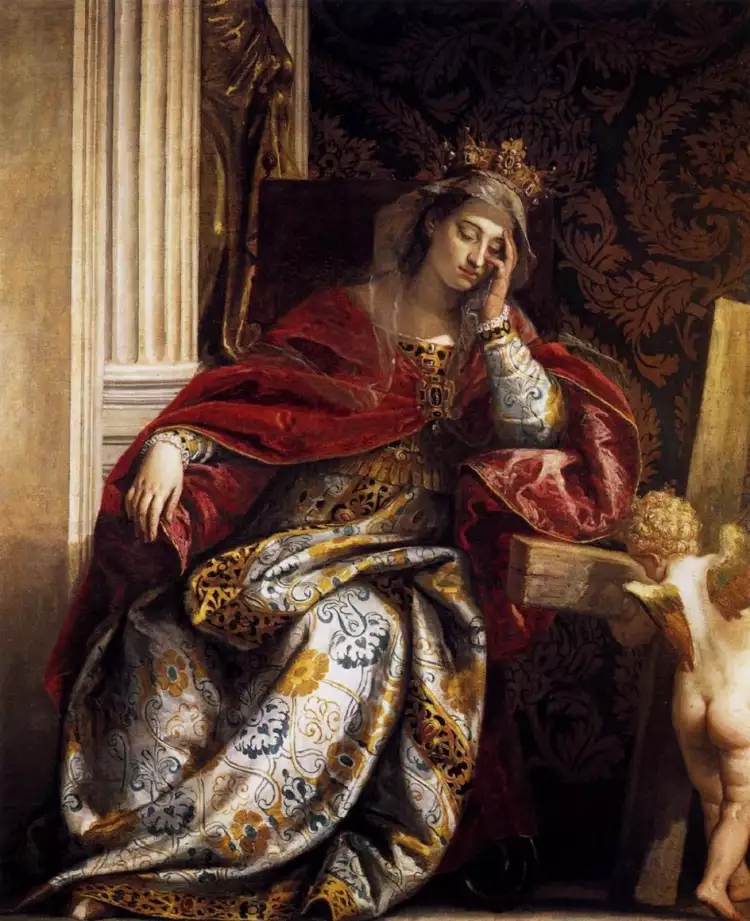 Renaissance. Paolo Veronese. The Vision of Saint Helen, 1580
Renaissance. Paolo Veronese. The Vision of Saint Helen, 1580
North of the Alps, the so-called Northern Renaissance continued to march, with its specific features: it was less influenced by classical motifs but still retained Gothic elements quite distinctly.
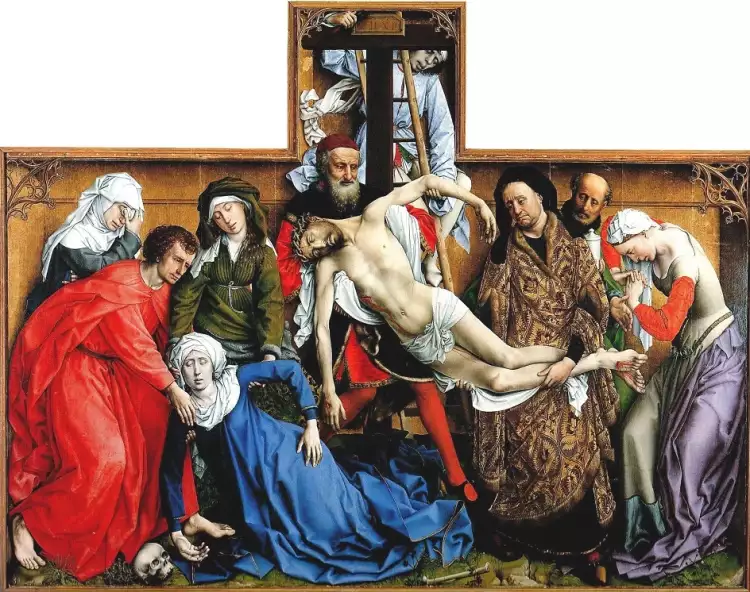 Renaissance. Rogier van der Weyden. The Descent from the Cross, 1435-1440
Renaissance. Rogier van der Weyden. The Descent from the Cross, 1435-1440
In addition, the Reformation had a significant ideological impact.
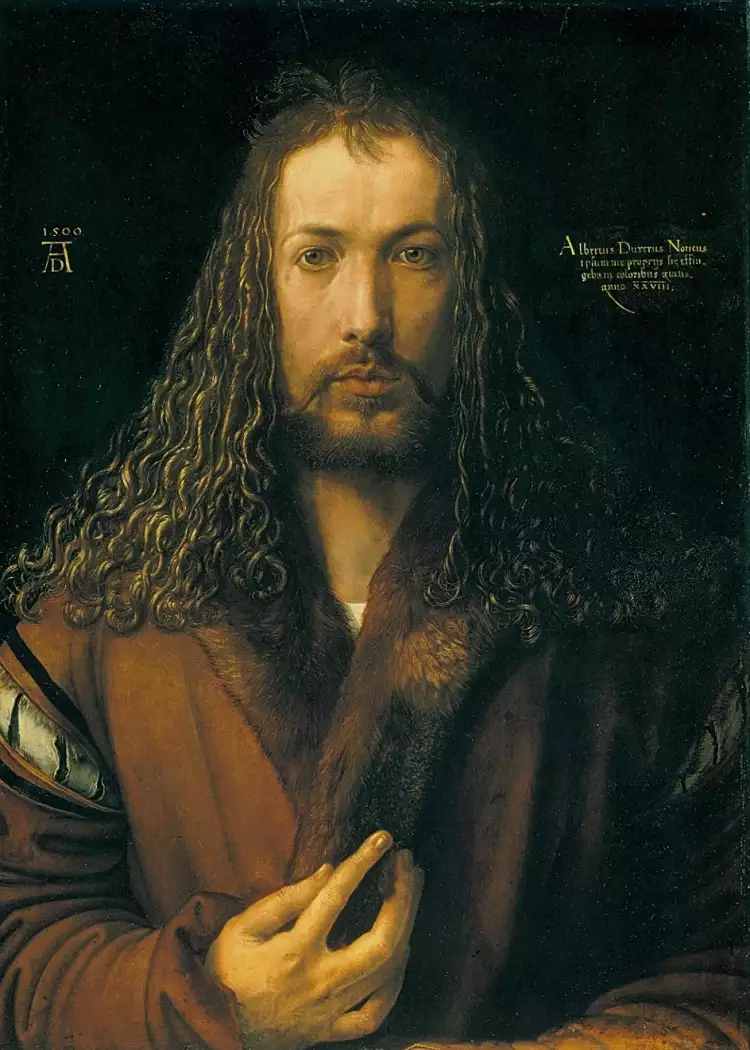 Renaissance. Albrecht Dürer. Self-Portrait at Twenty-Eight, 1500
Renaissance. Albrecht Dürer. Self-Portrait at Twenty-Eight, 1500
The Renaissance era began later in some countries than in Italy (such as France and Spain) and ended later, in the early 17th century.
Overall, the 16th century was a turning point for European culture. Europe was in turmoil. Witches were burned, bloody religious massacres occurred, and heretics were executed. Radical sects emerged, and apocalyptic moods grew... The ideals of Renaissance humanism already seemed outdated. The new realities were much better reflected in the mannerism's complexity, the contrasts of the red and black of Caravaggio, and the dramatic chaos of the Baroque.
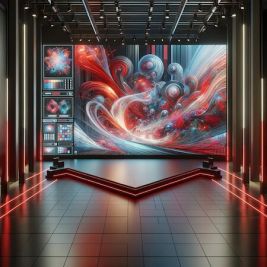 Digital and Interactive Art: Redefining User Experience in Contemporary Art
Digital and Interactive Art: Redefining User Experience in Contemporary Art 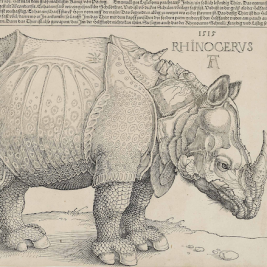 The engraving "Rhinoceros" by Albrecht Dürer - Europe's acquaintance with a curious beast
The engraving "Rhinoceros" by Albrecht Dürer - Europe's acquaintance with a curious beast 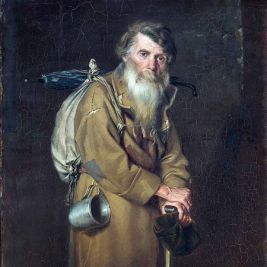 The painting "The Wanderer" by Vasily Grigorievich Perov portrays the image of noble poverty and human dignity
The painting "The Wanderer" by Vasily Grigorievich Perov portrays the image of noble poverty and human dignity 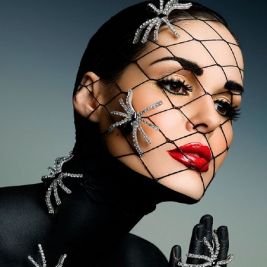 Glamour in photography is a beautiful genre with elements of elegance and luxury
Glamour in photography is a beautiful genre with elements of elegance and luxury 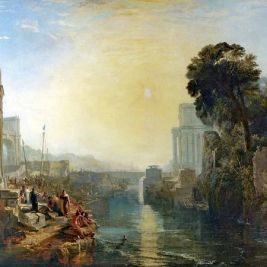 The painting "Dido building Carthage" by William Turner is the artist's beloved creation, which he wanted to take with him to his grave
The painting "Dido building Carthage" by William Turner is the artist's beloved creation, which he wanted to take with him to his grave  The painting "The Beekeeper" by Ivan Kramskoi is an expressive peasant figure against the backdrop of a landscape
The painting "The Beekeeper" by Ivan Kramskoi is an expressive peasant figure against the backdrop of a landscape 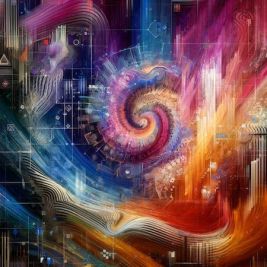 The Rise of Generative Art: Bridging Technology and Creativity
The Rise of Generative Art: Bridging Technology and Creativity 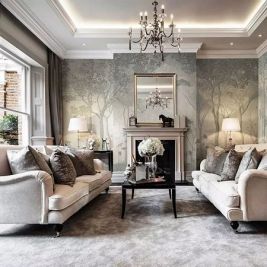 Neoclassical style in interior design is a modern interpretation of the noble traditions of antiquity
Neoclassical style in interior design is a modern interpretation of the noble traditions of antiquity  Silver - a noble metal
Silver - a noble metal 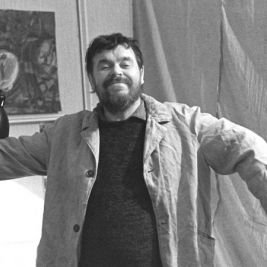 Anatoly Zverev — an unrecognized genius of the Soviet era
Anatoly Zverev — an unrecognized genius of the Soviet era